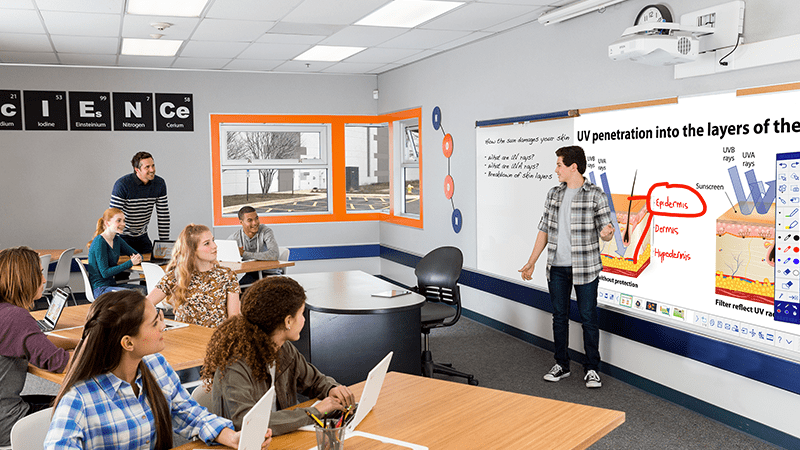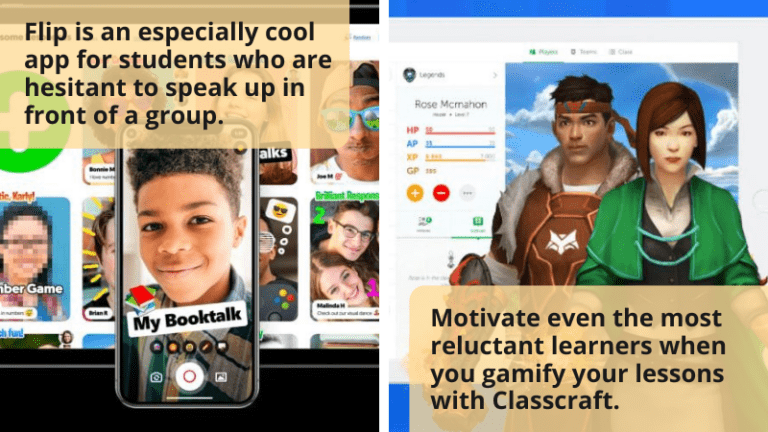For many adults, memories of their classroom learning experience likely include an image of squinting students shifting around the room and dodging each other’s heads while trying fruitlessly to copy down class notes. The focal point of this vision is a not-so-nostalgic humming, hot-to-the-touch overhead machine.
Wouldn’t it be great if all students could see and participate?
Thankfully, for today’s students, it’s possible because projectors have come a long way. They are interactive, their display size is much bigger and brighter, and the software used helps teachers create a classroom environment where participation flows easily between students at their desk to the front of the room.
In a classroom that uses the newest generation of interactive projectors, lessons are more dynamic and student engagement increases.
Want to transform your classroom with interactive projectors? Here are nine proven strategies.
1. Wow them with videos.
We all know how frustrating it is to sit behind the “tall person” at the movie theater, and we certainly don’t want that for our students. The problem with flat screens is they restrict the size of the image, which creates barriers (sometimes literally) for active viewing.
Because we often can’t control all aspects of classroom configuration, interactive projectors solve this problem in a major way. These interactive projectors bring the big screen to your classroom with up to 100-inch screen projections on any surface (even a wall) and, remarkably, with no glare. Unlike a bulky flat screen, you can rest assured that all students can view the screen from any angle, keeping them interested and engaged.
Tip: If you already have a whiteboard, you can use it as a projection surface for your interactive projector. Another nice benefit of projectors over flat screens—you don’t lose whiteboard space!
2. Use interactive digital content.
Get students involved in the lesson. Gone are the days when the teacher was the only one allowed to draw on the touch-screen device. Let students manipulate content using their fingers or pens. Online games like Quizlet, Socratic and Kahoot! become even more fun when played at super size. Or try the online science experiments at Go-Lab, in which students can build their own circuits, test gravity, buoyancy, and more.
3. Create a display that’s truly super-sized.
You have the option of using two projectors side by side to create an ultra-wide, interactive display. The interactivity between these two devices can be used to project an image on one side while utilizing interactive content on the other. With “drag and drop” movable pieces and the ability to write at the same time, students can solve math problems and revise essays together. Not to mention, the relatively low cost of interactive projectors, as compared to flat screens, makes having two in the same classroom actually achievable for most schools.
4. Model your thinking.
One of the best methods of engaging students is to show your thought process as you work through a piece of reading, an experiment, or a problem. Now this is easier than ever. With an interactive projector, you can use a document camera, tablet, or other device to take pictures of real objects and then project those images to large-scale. You and your students might work together to mark up passages for close reading, solve a complicated math problem, or show the parts of a leaf or a frog’s digestive system.
5. Stay on top of classroom management through content sharing.
When you want students to dive deeply into the lesson, you can easily share your projection screen with student devices. Integrating interactive projectors with student devices, such as Chromebooks, PCs, Androids, or Apple products, allows you to send a math problem or exit-ticket prompt to students for individual completion.
In addition, once complete, you can review those student responses using built-in projector software, selecting individual student screens to project back on the board. This is a great tool for student accountability, while also providing an easy means for immediate feedback.
6. Take your content to new surfaces.
Because interactive projectors do not have defined borders, learning is not limited. You can create an interactive experience on any surface. In fact, you can even project on tables. For example, you can project a map onto a classroom table so students can mark and draw the best path to take from point A to point B. This level of flexibility means you can take your students’ learning to the place that best meets their needs.
7. Set the mood with interactive classroom décor.
Setting the mood for learning can require a lot of money, time, and effort, especially when it comes to decorating an entire wall. However, with the beautiful, large display of an interactive projector, you can create homey, relaxing, and educationally sound décor in seconds.
On a cold, gloomy winter day, project a beautiful, high-definition fireplace video, complete with crackling wood, to create a comfortable, warm environment for learning. Or liven the mood by projecting a beautiful beach scene. You can find high-definition videos to support your content, too. If, for instance, you’re studying the rain forest, you could project a beautiful rain forest scene, complete with ambient rain forest white noise. There are even ambient videos for scenes from Harry Potter. With an interactive projector, you can turn any wall into classroom décor made for learning.
8. Take a virtual field trip.
Creating beautiful scenes on your walls is a great start, but why be confined by the walls of the classroom when your interactive projector can take your students to new places? You can use your interactive projector to create a global classroom, beyond the walls, without ever leaving your school.
Go on a Google Lit Trip and engage your students with an interactive journey into their favorite books; join surgeons in the operating room for a live open-heart surgery. With your interactive projector, you can rest assured that all students will have a front seat to the action.
9. Hold meet-ups with other classes.
After visiting these new places, you now can invite experts from all over the world into your classroom via Skype or Google Hangouts. Students can interact with authors, scientists, athletes, politicians, and even other students from across the world, creating a truly global classroom, with just the touch of a button.
Plus, with the large display and high quality of the interactive projector, your students will feel like your visitor is right in the room with them.
We’d love to know. How are you using interactive projectors in the classroom? Please share in the comments and we’ll add your ideas to this list.
P.S. Here’s a link to learn more about the interactive projector options available from Epson, if you’re curious. We hear great things from educators who are using them in their schools.


